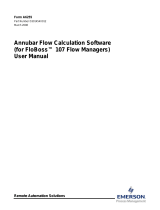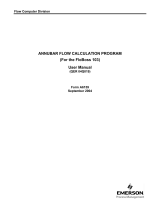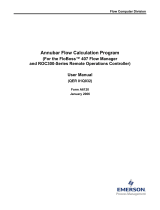Page is loading ...

www.rosemount.com
¢00825-0300-4809k¤
Quick Installation Guide
00825-0100-4031, Rev AA
April 2005
Duct Mount 285 Annubar
Step 1: Location and Orientation
Step 2: Installation Preparation
Step 3: Installation
Step 4: Mount the Transmitter
Product Certifications
Start
End
Rosemount 285 Annubar
®
Duct Mount
00825-0100-4031_Rev AA.fm Page 1 Monday, March 28, 2005 11:10 AM
Product Discontinued December 2009

Quick Installation Guide
00825-0100-4031, Rev AA
April 2005
Duct Mount 285 Annubar
2
© 2005 Rosemount Inc. All rights reserved. All marks property of owner. Rosemount and the Rosemount logotype are
registered trademarks of Rosemount Inc.
STEP 1: LOCATION AND ORIENTATION
Correct location in the duct is important for accurate measurement. See Table 1 on page 3
for proper installation locations.
Straight-run Installations
The recommended straight-run duct lengths upstream are 7W or 7H; downstream, 2W or
2H. Installation across the longest dimension is preferred.
Rosemount Inc.
8200 Market Boulevard
Chanhassen, MN USA 55317
T (US) (800) 999-9307
T (Intnl) (952) 906-8888
F (952) 949-7001
Emerson Process Management GmbH & Co. OHG
Argelsrieder Feld 3
82234 Wessling
Germany
T 49 (8153) 9390
F49 (8153) 939172
Emerson Process Management Asia Pacific
Private Limited
1 Pandan Crescent
Singapore 128461
T (65) 6777 8211
F (65) 6777 0947/65 6777 0743
Beijing Rosemount Far East Instrument Co.,
Limited
No. 6 North Street,
Hepingli, Dong Cheng District
Beijing 100013, China
T (86) (10) 6428 2233
F (86) (10) 6422 8586
IMPORTANT NOTICE
This installation guide provides basic guidelines for Rosemount 285 Annubar. It does not
provide instructions for configuration, diagnostics, maintenance, service, troubleshooting,
Explosion-proof, Flame-Proof, or instrinsically safe (I.S.) installations. Refer to the 285
Annubar reference manual (document number 00809-0100-4028) for more instruction.
This manual is also available electronically on www.rosemount.com.
WARNING
Process leaks may cause harm or result in death. To avoid process leaks, only use
gaskets designed to seal with the corresponding flange and o-rings to seal process
connections. Flowing medium may cause the 285 Annubar assembly to become hot and
could result in burns.
2W
W
H
7W
7H
W
H
2H
285/15-490024-901,
15-490025-901.eps
00825-0100-4031_Rev AA.fm Page 2 Monday, March 28, 2005 11:10 AM

Quick Installation Guide
00825-0100-4031, Rev AA
April 2005
Duct Mount 285 Annubar
3
Elbow Installations
The unit will measure accurately when installed 2 duct widths (height) downstream of a 90°
elbow in plane with the elbow.
Special Installations
For unique duct configurations, consult the factory.
Table 1. Minimum straight duct requirements for the 285 Annubar
Upstream Length Downstream Length
7W 2W
7W 2W
15W 2W
7W 2W
15W 2W
H
W
2W
W
H
2H
285/15-490026-901,
15-490027-901.eps
H
W
2W
7W
285/15-490028-901
H
W
7W
2W
285/15-490029-901
2W
H
W
15W
285/15-490030-90
1
2W
H
W
7W
285/15-490031-90
1
15W
2W
3.864
W
DAMPER
285/15-490032-901
00825-0100-4031_Rev AA.fm Page 3 Monday, March 28, 2005 11:10 AM

Quick Installation Guide
00825-0100-4031, Rev AA
April 2005
Duct Mount 285 Annubar
4
STEP 2: INSTALLATION PREPARATION
Operating Limitations
For the Annubar to produce accurate, repeatable flow measurement, the following must be
considered. The maximum allowed pressure and temperature limits are:
• Annubar Type D1 (duct mount without compression fitting): 10 psig @ -40°F to 850°F.
• Annubar Type D2 (duct mount with compression fitting): 10 psig @ -40°F to 300°F.
Annubar Installation Preparation
1. Make sure there is enough clearance to insert the Annubar into the duct.
2. Mark the mounting location of the Annubar, locating it along the center line of the
rectangular duct, or anywhere on the circumference of a round duct. Mark horizontal and
vertical center lines through the mounting location. For duct mount Annubars without
compression fitting (threaded stud welded to tip of sensor), extend the center line to the
opposite duct wall (or 180° around a circular duct), as shown in Figure 1.
Figure 1.
3. Measure and mark the locations of the mount screw holes and the opposite side support
hole (for Annubars with threaded stud welded to sensor tip) (see Table 2).
Figure 2.
Table 2. Installation dimensions inches (mm)
Annubar Model Number A
285xxxxxxxxxx1x 0.75 (19.05)
285xxxxxxxxxx2x 1.31 (33.27)
285/15-490013-903,
15-490033-903
A
H/2
A
A
A
H
A
A
Ø
A
A
180°
285/15-490013-901,
15-490034-901.eps
00825-0100-4031_Rev AA.fm Page 4 Monday, March 28, 2005 11:10 AM

Quick Installation Guide
00825-0100-4031, Rev AA
April 2005
Duct Mount 285 Annubar
5
4. Drill or punch holes B and D (Table 3) and drill or punch holes C (Table 4).
Figure 3.
5. Deburr all holes.
STEP 3: INSTALLATION
Duct-Mount without Compression Fitting (Annubar type D1)
1. Place the gasket over the end of the probe and push it up against the mounting flange.
Alternatively, a high-temperature gasket sealant may be used.
2. Insert the end of the Annubar through the mounting hole, and push it through the duct
until the threaded stud protrudes through the hole on the opposite side of the duct.
Figure 4.
Table 3. Installation dimensions inches (mm)
Annubar Model Number B D
285xxxxxxxD1x1x 0.75 (19.05) 0.38 (9.65)
285xxxxxxxD1x2x 1.31 (33.27) 0.38 (9.65)
285xxxxxxxD2x1x 0.75 (19.05) not applicable
285xxxxxxxD2x2x 1.31 (33.27) not applicable
Table 4. Hole drill size for #12 self-tapping screws (C-dimension) inches (mm)
Hole Required
Duct Wall Thickness Hole Size Drill Size
less than 0.036 (0.91) 0.166 (4.2) #19
0.048 (1.22) 0.169 (4.3) #18
0.060 (1.52) 0.177 (4.5) #16
0.075 (1.91) 0.182 (4.6) #14
0.105 (2.67) 0.185 (4.7) #13
0.125 (3.18) 0.196 (5.0) #9
0.135 (3.43) 0.196 (5.0) #9
0.164 (4.17) 0.201 (5.1) #7
C
B
D
D
B
C
285/15-490014-901,
15-490035-901.eps
FOR HIGH TEMPERATURE
5/16-18 STUD
GASKET OR SEALANT
ANNUBAR
FOR HIGH TEMPERATURE
5/16-18 STUD
GASKET OR SEALANT
A
NNUBAR
285/15-490015-901,
15-490036-901
00825-0100-4031_Rev AA.fm Page 5 Monday, March 28, 2005 11:10 AM

Quick Installation Guide
00825-0100-4031, Rev AA
April 2005
Duct Mount 285 Annubar
6
3. Push the flange and gasket flush against the duct wall; align the flow arrow in the
direction of flow and fasten the flange to the duct using the #12 sheet metal screws
provided.
Figure 5.
4. On the opposite side of the duct, place the
5
/16-in. lock washer over the stud, screw on
the
5
/16 nut, and tighten. Depending on the pressure in the duct, it may be necessary to
add some high temperature gasket sealant where the stud protrudes through the duct
wall.
Duct Mount With Compression Fitting (Annubar type D2)
1. Place gasket against the mounting flange. Alternatively, a high-temperature gasket
sealant may be used.
2. Push the flange and gasket flush against the duct wall, and fasten the flange to the duct
using the #12 sheet metal screws provided.
STUD
1/4" SHEET METAL SCREWS
285/15-490016-901,
15-490017-901
STUD
1/4" SHEET
METAL SCREWS
285/15-490037-901,
15-490038-901
STUD
LOCK WASHER
NUT
ANNUBAR
DUCT
DUCT
LOCK WASHER
NUT
STUD
ANNUBA
R
285/15-490018-901,
/15-490039-901
00825-0100-4031_Rev AA.fm Page 6 Monday, March 28, 2005 11:10 AM

Quick Installation Guide
00825-0100-4031, Rev AA
April 2005
Duct Mount 285 Annubar
7
Figure 6.
3. Remove the packing gland from the Annubar, and thread it into the threaded coupling,
using teflon tape or pipe sealant.
Figure 7.
4. Remove the packing from the envelope and wrap it around the Annubar three full turns.
Insert the Annubar into the mounting until the packing is completely contained within the
glad, and the tip of the Annubar is contacting the opposite side of the duct wall. Place the
lock washers over the studs on the packing gland and hand tighten the nuts.
Figure 8.
5. Align the flow arrow on the Annubar with the flow direction in the duct and tighten the
nuts on the packing.
NOTE
Do not over tighten the packing, as this can lead to deforming the opposite wall of the duct.
6. Observe the opposite side of the duct and ensure that the ducting has not deformed.
GASKET OR SEALANT
FOR HIGH TEMPERATURE
DUCT MOUNT PLATE
WITH THREADED
COUPLING
1/4" SHEET
METAL SCREWS
285/15-490022-901
THREADED
PACKING GLAND
COUPLING
TEFLON TAPE OR
PIPE SEALANT
285/ 15-490040-901
PACKING FROM
A
NNUBAR ASSEMBLY
ENVELOPE
(3) THREE FULL
TURNS
285/ 15-490041-901
00825-0100-4031_Rev AA.fm Page 7 Monday, March 28, 2005 11:10 AM

Quick Installation Guide
00825-0100-4031, Rev AA
April 2005
Duct Mount 285 Annubar
8
STEP 4: MOUNT THE TRANSMITTER
Transmitter Mounting, Direct Mount Head with Valves
It is not necessary to retract the Annubar when direct mounting a transmitter with valves.
1. Place Teflon
®
(PTFE) O-rings into grooves on the face of head.
2. Align the high side of the transmitter to the high side of the sensor (“Hi” is stamped on the
side of the head) and install.
3. Tighten the nuts in a cross pattern to 400 in•lb (45 N•m).
Transmitter Mounting, Direct Mount Head without Valves
1. Place Teflon (PTFE) O-rings into grooves on the face of head.
2. Orient the equalizer valve(s) so they are easily accessible. Install a manifold with the
smooth face mating to the face of the head. Tighten in cross pattern to a torque of 400
in•lb (45 N•m).
3. Place Teflon (PTFE) O-rings into grooves on the face of the manifold.
4. Align the high side of the transmitter to the high side of the sensor (“Hi” is stamped on the
side of the head) and install.
5. Tighten the nuts in a cross pattern to 400 in•lb (45 N•m).
Transmitter Mounting with Remote Mount Head
Temperatures in excess of 250 °F (121 °C)at the electronics will damage the transmitter.
Remote mounted electronics are connected to the sensor by means of impulse piping,
which allows service flow temperatures to decrease to a point where the electronics are no
longer vulnerable.
Different impulse piping arrangements are used depending on the process fluid and must be
rated for continuous operation at the pipeline design pressure and temperature. A minimum
of
1
/2 in. (12 mm) outer diameter stainless steel tubing with a wall thickness of at least 0.035
in. (1 mm) is recommended. Threaded pipe fittings are not recommended because they
create voids where air can become entrapped and create leakage points.
The following restrictions and recommendations apply to impulse piping location:
1. Impulse piping that runs horizontally must slope at least one inch per foot (83 mm/m).
• Slope downward (toward the electronics) for liquid and steam applications
• Slope upward (toward the electronics) for gas applications.
2. For applications with temperature below 250 °F (121 °C), impulse piping should be as
short as possible to minimize temperature changes. Insulation may be required.
3. For applications above 250 °F (121 °C), impulse piping should have a minimum length of
one foot (0.3048 m) for every 100 °F (38°C) temperature increase over 250 °F (121 °C).
Impulse piping must be non-insulated to reduce fluid temperature. Any threaded
connections should be checked after the system reaches the intended temperature
because connections may come loose with contraction and expansion caused by
temperature change.
4. Outdoor installations for liquid, saturated gas, or steam may require insulation and heat
tracing to prevent freezing.
5. When impulse piping is longer than six feet (1.8 m) the high and low impulse lines must
be positioned together to maintain equal temperature. They must be supported to
prevent sagging and vibration.
00825-0100-4031_Rev AA.fm Page 8 Monday, March 28, 2005 11:10 AM

Quick Installation Guide
00825-0100-4031, Rev AA
April 2005
Duct Mount 285 Annubar
9
6. Impulse lines should be positioned in protected areas or against walls or ceilings. Use
appropriate pipe sealing compound rated for the service temperature on all threaded
connections. Do not place the impulse piping near high temperature piping or equipment.
An instrument manifold is recommended for all installations. Manifolds allow an operator to
equalize the pressures prior to zeroing and isolates the process fluid from the electronics.
Figure 9. Valve Identification for 5-valve and 3-Valve Manifolds
Table 5. Description of Impulse Valves and Components
5-Valve Manifold 3-Valve Manifold
Name Description Purpose
Components
1 Electronics Reads Differential Pressure
2 Manifold Isolates and equalizes electronics
Manifold and Impulse Valves
PH Primary Sensor
(1)
(1) High Pressure
High and low side pressure process connections.
PL Primary Sensor
(2)
(2) Low Pressure
DVH Drain/Vent Valve
(1)
Drains (for gas service) or vents (for liquid or steam service) the DP
electronics chambers
DVL Drain/Vent Valve
(2)
MH Manifold
(1)
Isolates high side or low side pressure from the process
ML Manifold
(2)
MEH Manifold Equalizer
(1)
Allows high and low pressure side access to the vent valve, or for
isolating the process fluid
MEL Manifold Equalizer
(2)
ME Manifold Equalizer Allows high and low side pressure to equalize
MV Manifold Vent Valve Vents process fluid
To PH To PL
MH
MV
ML
DVLDVH
MELMEH
2
1
To PH To PL
MH
ME
ML
DVLDVH
2
1
00825-0100-4031_Rev AA.fm Page 9 Monday, March 28, 2005 11:10 AM

Quick Installation Guide
00825-0100-4031, Rev AA
April 2005
Duct Mount 285 Annubar
10
STEP 4 CONTINUED...
Recommended Installations
Gas Service
Secure the electronics above the sensor to prevent condensable liquids from collecting in
the impulse piping and the DP cell.
Liquid Service (up to 250 °F (121 °C))
Secure the electronics below the sensor to ensure that air will not be introduced into the
impulse piping or the electronics.
Steam or Liquid Service (above 250 °F (121 °C))
Mount the electronics below the process piping, adjust 10 to 15 degree above direct vertical
down. Route the impulse piping down to the electronics and fill the system with cool water
through the two tee fittings.
Figure 10. Gas Figure 11. Liquid
Figure 12. Horizontal Line Figure 13. Vertical Line
00825-0100-4031_Rev AA.fm Page 10 Monday, March 28, 2005 11:10 AM

Quick Installation Guide
00825-0100-4031, Rev AA
April 2005
Duct Mount 285 Annubar
11
PRODUCT CERTIFICATIONS
Approved Manufacturing Locations
Rosemount Inc. — Chanhassen, Minnesota USA
European Directive Information
The EC declaration of conformity for all applicable European directives for this product can
be found on the Rosemount website at www.rosemount.com. A hard copy may be obtained
by contacting our local sales office.
European Pressure Equipment Directive (PED) (97/23/EC)
Rosemount 285 Annubar — Refer to EC declaration of conformity for conformity
assessment
Pressure Transmitter — See appropriate Pressure Transmitter QIG
00825-0100-4031_Rev AA.fm Page 11 Monday, March 28, 2005 11:10 AM

Quick Installation Guide
00825-0100-4031, Rev AA
April 2005
Duct Mount 285 Annubar
12
00825-0100-4031_Rev AA.fm Page 12 Monday, March 28, 2005 11:10 AM
/





